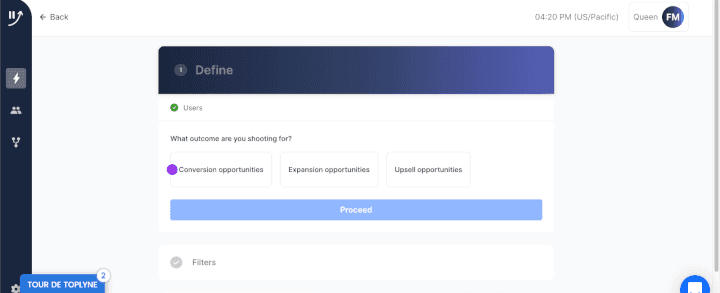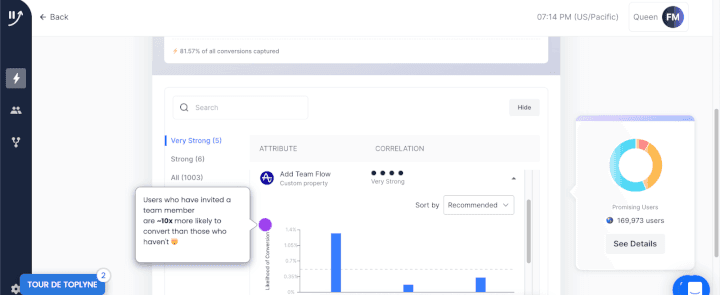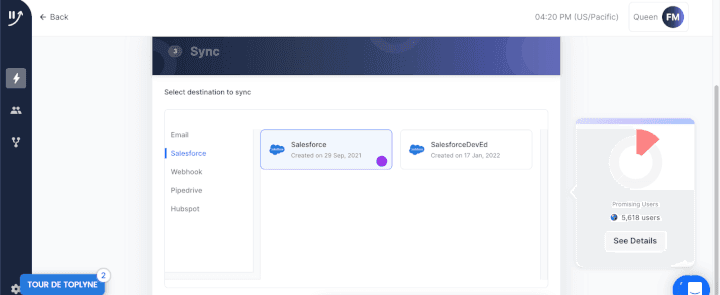The Ultimate Guide to Product Led Sales (Process, Benefits)
The Ultimate Guide to Product Led Sales (Process, Benefits)
The Ultimate Guide to Product Led Sales (Process, Benefits)
Explore what product led sales is, how you can transition to a product-led sales company, and how your business can benefit from it.
Explore what product led sales is, how you can transition to a product-led sales company, and how your business can benefit from it.
Explore what product led sales is, how you can transition to a product-led sales company, and how your business can benefit from it.



Traditional sales tactics are taking a backseat.
Cold calls and email campaigns have few takers today.
The front-row ticket 🎟️ is reserved for product led sales (PLS) — a new customer-centric and personalized approach to sales.
This product led approach helps you spot the leads likely to convert quickly without the stress and effort typically associated with traditional enterprise sales.
Ready to leave behind your ancient sales growth tactics and step into the 21st century with PLS?

In this article, we’ll cover what product led sales is, the things you need to do to become a product led sales company, and the benefits of PLS.
Let’s go!
What is Product-Led Sales?
Product-led sales (PLS) is a customer-centric sales motion used widely by companies already employing a PLG strategy (product led growth strategy).
PLS helps you identify well-qualified prospects quickly and reduce friction in the sales cycle.
With PLS, you can create a sales approach based on how customers want to buy instead of how you want to sell to them.
Want in?

The best part?
PLS is ideal for product led companies!
Wondering how the product led growth model (PLG model) is different from the sales led growth model (SLG model)?
Check out our detailed comparison of product led vs sales led growth.
You can also check out these 5 tips for B2B product-led growth.
Top-Down Sales and Product Leads
In the realm of B2B sales, the top-down sales approach involves targeting high-level decision-makers within an organization, such as C-suite executives or senior managers, who have the authority to make purchasing decisions.
This strategy can be particularly effective when combined with product-led tactics. By identifying and nurturing product-qualified leads (PQLs) who have demonstrated significant engagement with the product, sales teams can approach these top-level executives with a compelling narrative about how their teams are already deriving value from the product.
This dual approach not only ensures that the decision-makers are aware of the product's benefits but also showcases its existing traction within their organization, making a stronger case for broader adoption and investment.
Integrating Top-Down and Product-Led Strategies
Successfully integrating top-down and product-led strategies can lead to a highly efficient and effective sales process. By leveraging product usage data to identify PQLs and combining this with a top-down outreach strategy, sales teams can create multiple touchpoints and paths for engagement.
This ensures that potential customers experience the product firsthand, while also receiving personalized communication and support from the sales team.
The result is a seamless and cohesive sales process that aligns with how modern customers prefer to buy—through a combination of self-service exploration and strategic human interaction. This integrated approach not only boosts conversion rates but also enhances customer satisfaction and long-term retention.
What Are the Main Components of a Product-Led Sales Strategy?
Before you incorporate product-led sales into your company’s growth strategy, let’s understand what it’s made of:
Your product should have a self-service aspect, like a free trial or freemium option.
Your salespeople will engage with new users or accounts once they’re already using the product.
Filtering product qualified leads based on user engagement.
Conducting personalized engagements with every potential customer.
Sounds exciting?
Awesome! Now we can show you how to become a PLS company.
5 Things to Do to Transition to a Product-Led Sales Organization
Here are some simple things you need to do to join the product-led sales club and watch your revenue growth dreams come true:
1. Ensure Product-led Sales is For You
Is the product-led approach really for you, or is it just something you think you need because everyone’s doing it?
If you own a SaaS company, you should probably hop on to the PLS train.
(Before it leaves the station 😜)

A product led approach is ideal if you have a simple product that any potential customer can learn to use or if you target small businesses.
But some companies might do better with a sales led approach.
For example, if you have a complex product or target larger firms, a sales led approach might be the best bet. That’s because large companies may not have the time to try several free trials and learn how your product works.
Either way, no harm in providing a free trial 🤷 People like to know what they’re investing in.
2. Create a Freemium Product
You know how most people end up buying a Netflix subscription after getting locked out of their friend/roommate/ex’s account? 🎬
It’s because they finally understand the value of what they’re missing out on 😢
That’s the value of a ‘freemium’ product!
And PLS can’t work without it.
If freemium isn’t your jam, create something close to it.
This might include sharing recorded demos 📹 or creating a customer experience that showcases the real product experience.
Once that’s set up, redesign your sales process to focus on:
Your buyer’s experiences throughout their customer journey rather than the tasks of your sales team and sales funnel. Gather regular data on customer success metrics like Net Promoter Score (NPS), customer feedback, ease of use, etc.
The user experience (UX) and how it motivates customers to purchase your product. The faster your customers find value in your product, the sooner you hit your sales and customer acquisition targets 🎯
3. Specify What Makes a Product Qualified Lead
A product qualified lead (PQL) is a lead who has found value in your product by using the freemium model or free trial.
To identify and track product qualified leads, define your value metrics like:
Feature adoption rate.
Customer lifetime value (CLTV).
Time spent in the app.
And more.
These metrics reflect the moment when your product successfully wows your lead. 😍

4. Get the Other Teams On Board
A product led growth or PLG company relies on all teams, including the sales team, working together to support the efforts of the product manager and the product team.
Start by introducing the new approaches, including the sales process, to the rest of your teams in your product led company. Ensure to include them as much as you can.
For example, the UX department and customer success team can create self-service support options to make users more independent — enhancing their customer journey.
Getting the other teams on board can make it easier to set a product led culture and employ your product-led sales strategy!
5. Use the Right Technology
All set for your PLS adventure?
Time for the magic touch of the perfect marketing software!
The right PLS software can help you speed up lead identification to boost revenue growth. 💰
Fortunately, we have just the solution: Toplyne!
Toplyne is an intuitive platform that lets growth teams at any SaaS company monetize their product led growth.
Use this magic wand of a tool to identify your PQLs and turn them into premium users with an enhanced customer experience.

The perfect fairy tale ending! ✨

Here are some of the ways Toplyne can help:
Integrate Toplyne’s intuitive product usage data with your existing marketing tools (Amplitude, Mixpanel, etc.) to determine which users have the highest potential to convert.

Experiment with various conversion strategies to accomplish your go-to-market strategy.

Drive self-serve conversions through in-product nudges (chatbots, promos, paywalls) or sales-assisted conversions.
Craft in-product tailored experiences to encourage users to invite more signups.

Equip your sales team with the most suitable information to close a sale, whether it’s product usage signals or billing information.

With such powers, you only need to spend time and energy on users with the real potential to become paid members. And the savings pile up! 😉
(Psst! Canva, Grafana Labs, and Invideo have already chosen Toplyne as their magic wand ✨).
Not convinced?
Here are some of the excellent benefits of a PLS strategy.
2 Crucial Benefits of Product-Led Sales
Here are two noteworthy benefits of PLS over a traditional enterprise sales strategy that product led companies can’t get enough of:
1. Richly Qualified Leads
When a product led sales person engages with a user, they already know how the customer uses your product.
Best part?
You can skip the frustrating discovery questions.

Soon, your sales rep will be able to predict each user’s behavior from product data, resulting in better customer retention and customer success.
Moreover, PLS is an intuitive, frictionless sales process reflecting the values that likely attracted a user to your product in the first place. So there’s always a higher possibility of acquiring qualified leads.
2. Cost and Time Efficient
Thanks to PLS, every sales person in a product led company is very familiar with which accounts or users have a higher tendency to buy. 💳
This way, your sales rep team doesn’t have to waste time and resources on leads that won’t ever convert. So forget about reaching out to hundreds of disinterested users. Focus on those who want you.
Smart, isn’t it? 😎
With such a targeted approach, you can avoid spending extra cash for each sales cycle. With time, the customer acquisition cost (CAC) will automatically drop!
Clearly, PLS sounds like a dream. But...
Is Product-Led Sales Right For You?
Product-led sales is like buying a pizza with extra cheese. 🤤
It’s almost always a good decision, especially if you have a Saas product!
But there’s no distinct way to employ the product led sales strategy flawlessly for any PLG company. As a result, your product team can adopt a unique PLS strategy that suits its needs.
Fortunately, Toplyne can help you effectively manage your PLS approach and growth strategy as well as let you experiment with various conversion strategies.
Sign up for Toplyne for free today to watch the PLS magic unfurl and boost your sales like never before!
Traditional sales tactics are taking a backseat.
Cold calls and email campaigns have few takers today.
The front-row ticket 🎟️ is reserved for product led sales (PLS) — a new customer-centric and personalized approach to sales.
This product led approach helps you spot the leads likely to convert quickly without the stress and effort typically associated with traditional enterprise sales.
Ready to leave behind your ancient sales growth tactics and step into the 21st century with PLS?

In this article, we’ll cover what product led sales is, the things you need to do to become a product led sales company, and the benefits of PLS.
Let’s go!
What is Product-Led Sales?
Product-led sales (PLS) is a customer-centric sales motion used widely by companies already employing a PLG strategy (product led growth strategy).
PLS helps you identify well-qualified prospects quickly and reduce friction in the sales cycle.
With PLS, you can create a sales approach based on how customers want to buy instead of how you want to sell to them.
Want in?

The best part?
PLS is ideal for product led companies!
Wondering how the product led growth model (PLG model) is different from the sales led growth model (SLG model)?
Check out our detailed comparison of product led vs sales led growth.
You can also check out these 5 tips for B2B product-led growth.
Top-Down Sales and Product Leads
In the realm of B2B sales, the top-down sales approach involves targeting high-level decision-makers within an organization, such as C-suite executives or senior managers, who have the authority to make purchasing decisions.
This strategy can be particularly effective when combined with product-led tactics. By identifying and nurturing product-qualified leads (PQLs) who have demonstrated significant engagement with the product, sales teams can approach these top-level executives with a compelling narrative about how their teams are already deriving value from the product.
This dual approach not only ensures that the decision-makers are aware of the product's benefits but also showcases its existing traction within their organization, making a stronger case for broader adoption and investment.
Integrating Top-Down and Product-Led Strategies
Successfully integrating top-down and product-led strategies can lead to a highly efficient and effective sales process. By leveraging product usage data to identify PQLs and combining this with a top-down outreach strategy, sales teams can create multiple touchpoints and paths for engagement.
This ensures that potential customers experience the product firsthand, while also receiving personalized communication and support from the sales team.
The result is a seamless and cohesive sales process that aligns with how modern customers prefer to buy—through a combination of self-service exploration and strategic human interaction. This integrated approach not only boosts conversion rates but also enhances customer satisfaction and long-term retention.
What Are the Main Components of a Product-Led Sales Strategy?
Before you incorporate product-led sales into your company’s growth strategy, let’s understand what it’s made of:
Your product should have a self-service aspect, like a free trial or freemium option.
Your salespeople will engage with new users or accounts once they’re already using the product.
Filtering product qualified leads based on user engagement.
Conducting personalized engagements with every potential customer.
Sounds exciting?
Awesome! Now we can show you how to become a PLS company.
5 Things to Do to Transition to a Product-Led Sales Organization
Here are some simple things you need to do to join the product-led sales club and watch your revenue growth dreams come true:
1. Ensure Product-led Sales is For You
Is the product-led approach really for you, or is it just something you think you need because everyone’s doing it?
If you own a SaaS company, you should probably hop on to the PLS train.
(Before it leaves the station 😜)

A product led approach is ideal if you have a simple product that any potential customer can learn to use or if you target small businesses.
But some companies might do better with a sales led approach.
For example, if you have a complex product or target larger firms, a sales led approach might be the best bet. That’s because large companies may not have the time to try several free trials and learn how your product works.
Either way, no harm in providing a free trial 🤷 People like to know what they’re investing in.
2. Create a Freemium Product
You know how most people end up buying a Netflix subscription after getting locked out of their friend/roommate/ex’s account? 🎬
It’s because they finally understand the value of what they’re missing out on 😢
That’s the value of a ‘freemium’ product!
And PLS can’t work without it.
If freemium isn’t your jam, create something close to it.
This might include sharing recorded demos 📹 or creating a customer experience that showcases the real product experience.
Once that’s set up, redesign your sales process to focus on:
Your buyer’s experiences throughout their customer journey rather than the tasks of your sales team and sales funnel. Gather regular data on customer success metrics like Net Promoter Score (NPS), customer feedback, ease of use, etc.
The user experience (UX) and how it motivates customers to purchase your product. The faster your customers find value in your product, the sooner you hit your sales and customer acquisition targets 🎯
3. Specify What Makes a Product Qualified Lead
A product qualified lead (PQL) is a lead who has found value in your product by using the freemium model or free trial.
To identify and track product qualified leads, define your value metrics like:
Feature adoption rate.
Customer lifetime value (CLTV).
Time spent in the app.
And more.
These metrics reflect the moment when your product successfully wows your lead. 😍

4. Get the Other Teams On Board
A product led growth or PLG company relies on all teams, including the sales team, working together to support the efforts of the product manager and the product team.
Start by introducing the new approaches, including the sales process, to the rest of your teams in your product led company. Ensure to include them as much as you can.
For example, the UX department and customer success team can create self-service support options to make users more independent — enhancing their customer journey.
Getting the other teams on board can make it easier to set a product led culture and employ your product-led sales strategy!
5. Use the Right Technology
All set for your PLS adventure?
Time for the magic touch of the perfect marketing software!
The right PLS software can help you speed up lead identification to boost revenue growth. 💰
Fortunately, we have just the solution: Toplyne!
Toplyne is an intuitive platform that lets growth teams at any SaaS company monetize their product led growth.
Use this magic wand of a tool to identify your PQLs and turn them into premium users with an enhanced customer experience.

The perfect fairy tale ending! ✨

Here are some of the ways Toplyne can help:
Integrate Toplyne’s intuitive product usage data with your existing marketing tools (Amplitude, Mixpanel, etc.) to determine which users have the highest potential to convert.

Experiment with various conversion strategies to accomplish your go-to-market strategy.

Drive self-serve conversions through in-product nudges (chatbots, promos, paywalls) or sales-assisted conversions.
Craft in-product tailored experiences to encourage users to invite more signups.

Equip your sales team with the most suitable information to close a sale, whether it’s product usage signals or billing information.

With such powers, you only need to spend time and energy on users with the real potential to become paid members. And the savings pile up! 😉
(Psst! Canva, Grafana Labs, and Invideo have already chosen Toplyne as their magic wand ✨).
Not convinced?
Here are some of the excellent benefits of a PLS strategy.
2 Crucial Benefits of Product-Led Sales
Here are two noteworthy benefits of PLS over a traditional enterprise sales strategy that product led companies can’t get enough of:
1. Richly Qualified Leads
When a product led sales person engages with a user, they already know how the customer uses your product.
Best part?
You can skip the frustrating discovery questions.

Soon, your sales rep will be able to predict each user’s behavior from product data, resulting in better customer retention and customer success.
Moreover, PLS is an intuitive, frictionless sales process reflecting the values that likely attracted a user to your product in the first place. So there’s always a higher possibility of acquiring qualified leads.
2. Cost and Time Efficient
Thanks to PLS, every sales person in a product led company is very familiar with which accounts or users have a higher tendency to buy. 💳
This way, your sales rep team doesn’t have to waste time and resources on leads that won’t ever convert. So forget about reaching out to hundreds of disinterested users. Focus on those who want you.
Smart, isn’t it? 😎
With such a targeted approach, you can avoid spending extra cash for each sales cycle. With time, the customer acquisition cost (CAC) will automatically drop!
Clearly, PLS sounds like a dream. But...
Is Product-Led Sales Right For You?
Product-led sales is like buying a pizza with extra cheese. 🤤
It’s almost always a good decision, especially if you have a Saas product!
But there’s no distinct way to employ the product led sales strategy flawlessly for any PLG company. As a result, your product team can adopt a unique PLS strategy that suits its needs.
Fortunately, Toplyne can help you effectively manage your PLS approach and growth strategy as well as let you experiment with various conversion strategies.
Sign up for Toplyne for free today to watch the PLS magic unfurl and boost your sales like never before!
Related Articles




Behavioral Retargeting: A Game-Changer in the Cookieless Era
Unlock the power of behavioral retargeting for the cookieless future! Learn how it personalizes ads & boosts conversions. #behavioralretargeting




All of Toplyne's 40+ Badges in the G2 Spring Reports
Our customers awarded us 40+ badges in G2's Summer Report 2024.




Unlocking the Full Potential of Google PMax Campaigns: Mastering Audience Selection to Double Your ROAS
Copyright © Toplyne Labs PTE Ltd. 2024
Copyright © Toplyne Labs PTE Ltd. 2024
Copyright © Toplyne Labs PTE Ltd. 2024
Copyright © Toplyne Labs PTE Ltd. 2024